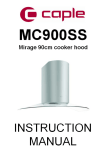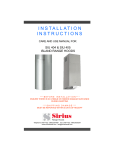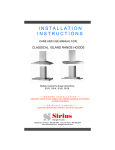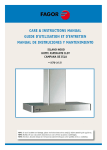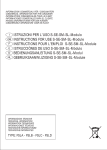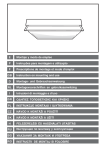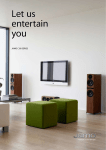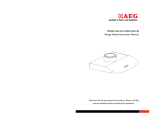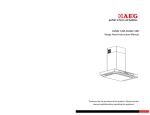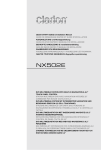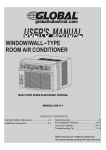Download Sirius Range Hoods SCH31A User's Manual
Transcript
I N S TA L L AT I O N INSTRUCTIONS CARE AND USE MANUAL FOR: POWER PACK RANGE HOODS Models covered by these instructions: SU900, SUT900, SCH31A ***BEFORE INSTALLATION*** ENSURE THERE IS NO VISIBLE OR HIDDEN DAMAGE SUSTAINED DURING SHIPPING ***SHIPPING DAMAGE*** MUST BE REPORTED WITHIN 5 DAYS OF RECEIPT Telephone (Toll Free): 866.528.4987 Fax (Toll Free): 866.365.9204 www.siriushoods.com [email protected] WARNINGS Thank you for purchasing a Sirius Range Hood. Please read all the instructions in this manual before installing the appliance. Save these instructions for future reference. The appliance is not intended for use by young children or infirm persons without supervision. Young children should be supervised to ensure they do not play with the appliance. If the range hood is vented, the air so vented must be ducted into a dedicated duct that is not showed with any other equipment whatsoever. All ducting must conform to all requirements of the local authority. If the range hood is to be used inside he same structure (home or building) as any equipment hat burns combustible material such as oil, coal, gas, etc. then pervision must be made for make up air. Under certain circumstances, the range hood could create a negative air pressure inside the structure. This negative air pressure must not exceed 0.04 mbar (please consult your local HVAC professional for guidance at this point). The use of combustible material in close proximity of the range hood must be avoided. When frying, please pay particular attention to fire risk due to grease. Being highly inflammable, fried oil is especially dangerous. In order to avoid possible fire risk, all instructions for greasefilter cleaning and for removing eventual grease deposits must be followed strictly. If the rating label in the cooker-hood shows the symbol , the appliance is built in class II and it does not need any ground connection. If the rating label in the cooker-hood does not show the symbol ,the appliance is built in class I and it needs the ground connection. Only use this appliance as an exhaust ventilation system for the removal of cooking vapors. DO NOT use to expel flammable substances or any other materials or vapors. The installation procedures in this manual are intended for qualified installers, service technicians or persons with similar qualified background. DO NOT attempt to install this appliance yourself. When performing the electrical connections on the appliance, please ensure that the current supply is provide with ground connection and that the voltage values correspond to those indicated on the label placed inside the appliance itself. Ensure that electrical power is turned off at source before commencing installation. All electrical wiring must be properly installed, insulated and grounded and conform to all applicable codes and standards. Make sure all existing ductwork is clean of grease build up, or ductwork should be replaced, if necessary, to avoid the possibility of a grease fire. Check all joints on ductwork to ensure proper connection and all joints should be properly taped. Be careful when cutting through ceilings or walls not to damage any hidden pipes or electrical wiring. Ensure your kitchen has sufficient air return vents to replace the exhausted air. TABLE OF CONTENTS BEFORE YOU BEGIN 1 DUCTING 1 External Venting Requirements 1 Duct Run Calculation 2 ELECTRICAL 2 Electrical Supply 2 INSTALLATION 3 Applications 3 Connecting Electricity and Ducting 4 Re-Circulating Requirements 4 OPERATING PROCEDURES 5 General Advice 5 Functions 5 MAINTENANCE 6 Cleaning the Filter 6 Cleaning the Hood 6 Light Bulb Replacement 6 WARRANTY 7 BEFORE YOU BEGIN The manufacturer declines all responsibility in the event of failure to observe the instructions given here for installation, maintenance and suitable operation of the product. The manufacturer further declines all responsibility for injury due to negligence and the warranty of the unit automatically expires due to improper maintenance and/or installation. BEFORE YOU BEGIN: It is advisable to test run the range hood before installation. Please read this entire manual and ensure that you are fully conversant with the requirements and limitations DUCTING (Not applicable if the range hood is used in re-circulating mode) WARNING: Do not vent this appliance into any other ductwork, spaces between walls, ceilings, attics, garages or any other confined space. External Venting Requirements When planning new ductwork, always look for the most direct route to the outside. Venting can be done through the roof or directly through the back outside wall. (See Figure 1 and 2) Only use rigid type metal ducting (plastic ducting is generally not Figure 1 1 permitted by code). Flexible ducting could restrict airflow by up to 50%. Always fasten connections with sheet metal screws and tape all joints with certified Silver Tape or Duct Tape. Do not use screws to fasten ductwork to the hood, only use tape as the screws will stop the dampers from opening and your hood will not work. This hood requires a 6” round duct outlet. You can increase the duct size of the duct run but never decrease it. Use the shortest and most direct route possible. Always, wherever possible, reduce the num ber of transitions and turns with as few sharp angles as possible. Figure 2 Two staggered 45 degree angles are better than one 90 degree. Make these turns as far away from the motor exhaust as possible, with as much space between each bend. Duct Run Calculation The maximum duct run before effecting the performance of the Maximum Run 6” or 3 1/4 x 10” duct 100 FT Deduct hood is 100’. Calculate your duct run by measuring linear feet and adding the elbows, transitions and caps based on the table alongside. The ducting connection to the hood must be in line with the central vertical axis of the range hood 1” away from the back wall on which the hood is to be mounted. Range hoods may interrupt the proper flow of combustion gases from fireplaces, gas furnaces and gas water heaters. 1FT To minimize the risk of drawing these lethal gases back into the home, please follow the heating equipment manufacturers safety standards and guidelines carefully. Transition used 5FT Refer to NFPA and ASHRAE for additional information. Side Wall with damper 30FT Roof Cap 30FT Each 90 elbow used 15FT Each 45 elbow used 9FT Each 6” or 3 1/4 x 10” duct Transition used Each 3’1/4 x 10” to 6” ELECTRICAL WARNING: All electrical work must be performed by a qualified electrician. Please ensure that the appropriate electrical codes or prevailing local building codes and ordinances are adhered to. Ensure that the electricity supply is disconnected at source. Do not use an extension cord or adapter plug with this appliance. This appliance must be grounded. Connect to a properly grounded branch circuit, protected by a 15 amp circuit breaker. Electrical Supply This range hood requires a 120V, 60Hz supply and draws a maximum of 3 amps. The electrical supply to the range hood should be at least 17” from the underside of the installed range hood. For a typical installation, where the underside of the range hood will be 30” above the counter top and the counter top is 36” above the floor level, the electrical supply should be 76” above floor level and no further than 3” to the right (as you face the wall) of the central axis of the range hood. 2 I N S TA L L AT I O N Applications The SUT900 can either be installed inside a wall cabinet (provided the inside depth is greater than 11”) or used in a custom designed wooden hood. Where installed directly into a wall cabinet, there are two options: Directly into the cabinet without any form of hood. Directly into the cabinet together with Sch31A where the Sch31A acts as a liner hood and is attached to either the underside of the cabinet or into the sides of the cabinets alongside. Depending on which model is used, prepare a cut-out in the underside of the wooden hood to allow the SUT900 to fit up into the hood (refer to figure 3 or 4). If Sch31A is being used, it can be held up under the cabinet and used as a template. Remember to make the depth 10.3”. Please ensure that the SUT900 is installed as far forward in the wooden hood as possible and centered over the cooking area. Sch 31A If Sch31A is to be used for under cabinet application, it should be installed now. Screw Sch 31A to the 4 hole locations. Make sure it lines up with the cut out in your cabinet (refer to figure 5). Figure 5 20.5 ” 19.4 ” Figure 3 For the 20.5” model, the cut out should 19.4” x 10.3”. 27.6 ” The SUT900 has pressure springs on the front and back that will “hook” onto the top surface of the underside of the hood when it is pushed up into the hole that has been cut out (refer to figure 6) 26.5 ”” Figure 4 For the 27.6” model, the cut out should be 26.5” x 10.3”. 3 Figure 6 There are four holes on the inside of the SUT900 to fix the unit into the edge of the base of the wooden hood (refer to figure 7). Connect the appropriate length of ducting to the fan exhaust point and join up with the ducting to the exterior. Do not fix the ducting to the range hood exhaust outlet with screws use duct tape. Use duct tape on all joints. Re-Circulating Requirements Figure 7 If the unit is to be used in the re-circulating mode, fit the carbon filters after the installation is complete (refer to Figure 9). Connecting Electricity and Ducting Please refer to the Electrical Supply section on page 2 for the required location of the electrical supply. CAUTION: Make sure the power is turned off at source. Make electrical connections (refer to Figure 8). Ensure that the plastic flaps at the exhaust outlet for the fan move freely and have not become jammed or stuck. Figure 9 The carbon filter fits in behind the aluminium grease filter. Ensure that the plastic tabs on the carbon filter are facing outwards otherwise it will be difficult to remove it later for replacement. A short length of ductwork must be connected from the exhaust outlet on the fan to wherever the air is to be exhausted. Allow sufficient space to connect the ductwork to the top of the exhaust outlet on the fan housing. Do not fix the ducting to the range hood exhaust outlet with screws, use duct tape. Duct tape should be used on all joints. Figure 8 4 O P E R AT I NG P R O C E D U R E S Read all the instructions before operating the appliance. Save these instructions for future reference. General Advice Ensure that the grease filters are in place. Without these components, operating blowers could catch on to hair, fingers and loose clothing. Keep fan, filters and surfaces clean of grease and fat. Always turn hood fan ON when cooking. NEVER leave cooking unattended. DO NOT USE WATER including wet dishcloths or towels, as a violent steam explosion may occur. Functions Power Pack Control A: Light ON/OFF button B: Blower Speed 1 (low) or OFF C: Blower Speed 2 (medium) D: Blower Speed 3 (high) E: Blower Speed 4 (intensive) F: 10 Minute Timer NEVER dispose cigarette ashes, ignitable substances or any foreign objects into blowers. Cooking that generates flame is not recommended as this hood is equipped with a thermal overload that will shut down the motor if it senses excessive heat. When frying, oil in the pan can easily overheat and ignite. Heat oil slowly in an appropriately sized pot (covering the entire burner) to reduce the risk of boiling over and burning In the event of a range top grease fire, observe the following: Switch OFF the range hood. Turn off the cook top then smother flames with a close fitting lid, cookie sheet or other metal tray. If the flames do not go out immediately. EVACUATE AND CALL THE FIRE DEPARTMENT. Never pick up a flaming pan – you may be burned. 5 Filter requires washing indicator: after 30 hours of use, all the buttons will light up to remind you that the grease filter should be cleaned. Follow the instructions for cleaning filters in this booklet. Once the grease filters have been cleaned and replaced, reset by pressing the timer button (F). Do not rely solely on this indicator. Generally, the grease filter should be washed on a regular basis to avoid grease filter fires. The blower should be turned on for approximately 5 minutes before cooking in order to establish air currents upward through the hood. Use the low speeds for normal use and the higher speeds for strong odors and fumes. MAINTENANCE The range hood should provide many years of trouble free use provided it is properly maintained. Be sure the lights are cool before cleaning the hood – they are halogen and become extremely hot. Cleaning the Filter The aluminium mesh filters should be washed by hand or in the dishwasher as required. Damaged and worn filters must be replaced immediately. (Do not operate blower when filters have been removed). Allow filters to dry before replacing them, otherwise water will be drawn into the blower. If a carbon filter has been fitted, this must be replaced every 6 months as a minimum, depending on usage and type of cooking that is performed. It is suggested that a spare set of carbon filters is kept on hand. These can be ordered from the supplier of your range hood. Cleaning the Hood The outside and interior of your hood should be wiped regularly with a clean, damp cloth and mild household dish detergent or degreaser. to react on the surface for a few minutes and then wipe with a clean dry cloth. On the surfaces that are exposed directly to heat from the cook-top, it is advisable to clean these regularly to avoid the deposits from becoming baked on. Do not use abrasive cleaning agents as these will destroy the brushed finish. Light Bulb Replacement (If in doubt, call 866.528.4987) Turn blower and lights off. Make sure the lights are cool. If new lights do not operate, check fuses and be sure globes and breakers are inserted correctly. Remove the glassblocking ring by prying out with a sharp, soft instrument such as a toothpick. (refer to Figure 10) Steel instruments will scratch the surface. Be careful that the glass does not fall out and break. Do not remove the entire fixture (socket) as this is very difficult to reinstall. Replace the appropriate bulb. Check parts brochure or specification sheets on our website. Wipe both sides of the glass whilst it is out. Re-insert the glass-blocking ring and fasten it. Use a good quality non-abrasive foaming type stainless steel cleaner for exterior surfaces. Follow the manufacturers directions. Generally the foam is sprayed onto a clean dry cloth and then applied to the stainless steel. Allow the foam Figure 10 6 T h r e e Ye a r L i m i t e d W a r r a n t y WARRANTY SERVICE To qualify for warranty service, you must notify Sirius Range Hoods at the address stated below or call toll free USA or Canada 1-866-528-4987 and provide the model number, description of the fault or defect and original date of purchase. Sirius reserves the right to request proof of original purchase. Sirius will at its sole option and discretion replace products that arrive damaged through shipping, provided shipping damage is reported as stated above within 5 business days of receipt of the shipped product or products. ONE YEAR SERVICE REPAIR WARRANTY: During the first year from date of original purchase, Sirius will, at its option, repair or replace, without charge, any product or part which is found to be defective under normal use and service. THREE YEAR PARTS WARRANTY: For three years from date of purchase, Sirius will provide free of charge, non-consumable replacement parts which are found to be defective under normal use and service. WHO IS COVERED: Sirius Range Hoods warrants to the original consumer purchaser of its products that such products will be free from defects in materials and workmanship for a period of three years from the original date of purchase. There are no other warranties, express or implied, including, but not limited to, implied warranties of merchantability or fitness for a particular purpose or application. WHAT IS NOT COVERED: This warranty does not extend to filters, lamps, batteries, ducts and ductwork components. This warranty does not cover normal maintenance and service or products or parts which have been subject to misuse, negligence, accident, improper maintenance or repair, faulty installation or installation contrary to recommended installation instructions. The warranty on glass screens is limited to manufacturing defects only and expressly excludes cracks and breakages as a result of faulty installation. Labor and associated costs associated directly with removal and re-installation are expressly excluded. The duration of any implied warranty is limited to the three year period as specified for the express warranty. Some states and provinces do not allow limitation on how long an implied warranty lasts, so the above limitation may not apply to you. Canada: 7 Sirius Range Hoods Ltd 1252 Speers Road Unit 11 Oakville, ON L6L 5N9 USA: Sirius Range Hoods Ltd 1051 Clinton Street Buffalo, NY 14206 Register Online! www.siriushoods.com/warranty.htm Staple Invoice Here. 8 USA: SIRIUS RANGE HOODS (USA) LTD. 1051 Clinton Street Buffalo, NY 14206 Telephone (Toll Free): 866.528.4987 Fax (Toll Free): 866.365.9204 CANADA: SIRIUS RANGE HOODS LTD. 1252 Speers Road Unit 11 Oakville, ON L6L 5N9 Telephone: 905.257.0046 Fax: 905.847.0330 www.siriushoods.com Email: [email protected]













